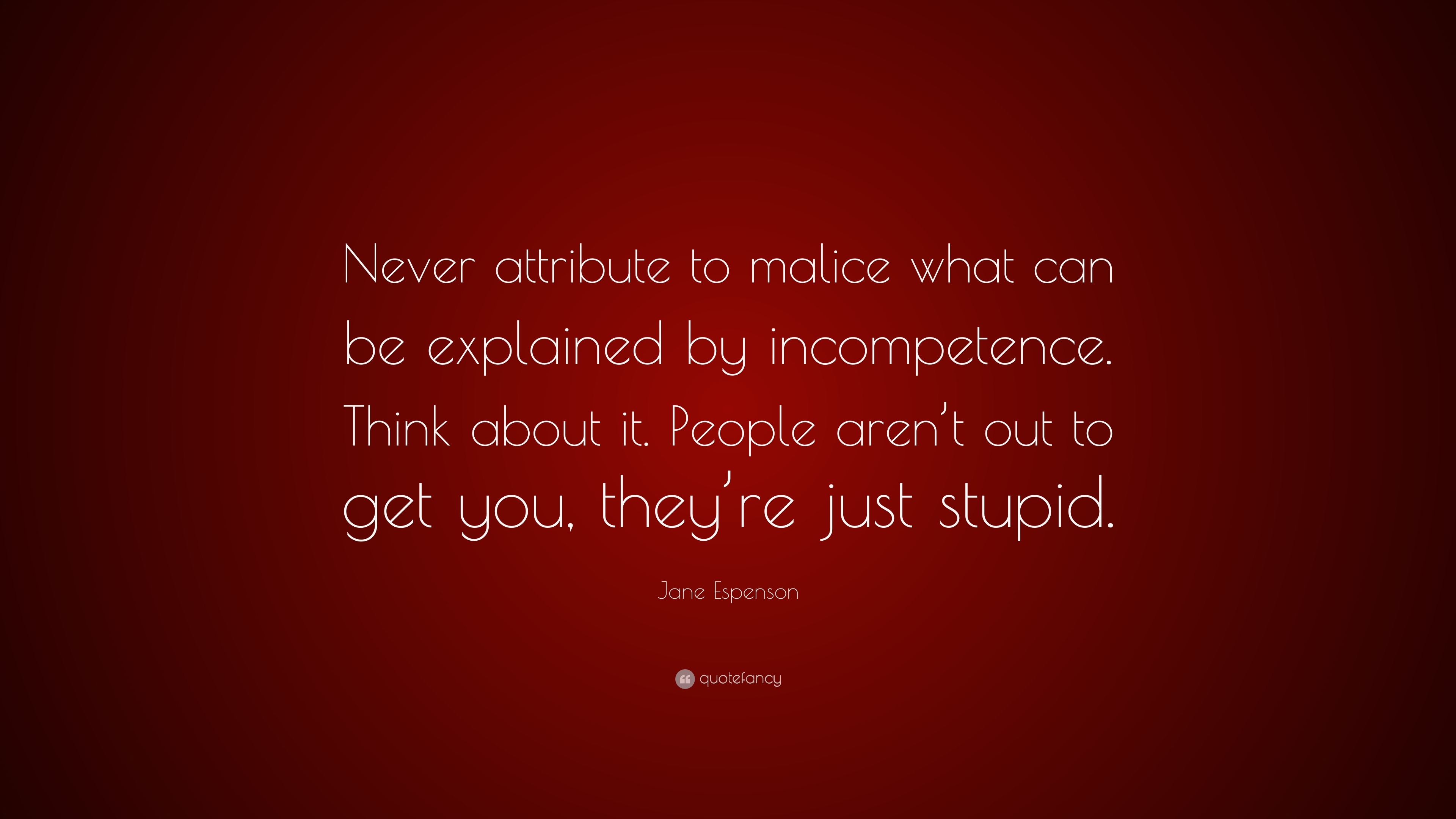
"Never attribute to malice that which is adequately explained by stupidity." Hanlon's Razor
Robert J. Hanlon of Scranton, Pennsylvania, is famous for his submission to a book compilation of various jokes related to Murphy's law: Murphy's Law Book Two : More Reasons Why Things Go Wrong! (1980) by Arthur Bloch.. Quotes [edit]. Never attribute to malice that which is adequately explained by stupidity. Murphy's Law Book Two : More Reasons Why Things Go Wrong!

Jane Espenson Quote “Never attribute to malice what can be explained by Think
Never attribute to malice that which can be adequately explained by stupidity, but don't rule out malice. A quote from, Albert Einstein

Malice Quote "Never attribute to malice..." Robert J. Hanlon 1409x929 http//ift.tt/2xIL3eL
The underlying axiom is "don't attribute to malice that which can be adequately explained by stupidity." This heuristic model has the following components:

Robert A. Heinlein Quote “Never attribute to malice that which can be adequately explained by
The wikipedia article discusses the history of the razor and how it can date back to many different people, including Heinlein. Hanlon's name got attached to it because he submitted it to a book on Murphyisms, Murphy's Law Book Two: More Reasons Why Things Go Wrong! which got it to the attention of several bloggers in the early 2000s, and its continued prominence today.

Malice Quote Malice Quotes Malice Sayings Malice Picture Quotes / Little blossom trapped
Hanlon's Razor: As stated by Robert. J. Hanlon, a heuristic telling us to "never attribute to malice that which is adequately explained by stupidity.". Heuristic: A mental shortcut that can help us make faster judgments in situations which are vague or complex. Heuristics can either be helpful or damaging depending on the context.

Jane Espenson Quote “Never attribute to malice what can be explained by Think
The phrase 'Hanlon's razor' was coined by Robert J. Hanlon, but it has been voiced by many people throughout history, as far back as 1774. Napoleon Bonaparte famously declared: 'Never ascribe to malice that which is adequately explained by incompetence.'. Goethe wrote similarly in The Sorrows of Young Werther in 1774:

Robert A. Heinlein Quote “Never attribute to malice that which can be adequately explained by
The cover of the September 1957 issue of Venture Science Fiction, in which Sturgeon first published "90% of everything is crud.". Sturgeon's law (or Sturgeon's revelation) is an adage stating "ninety percent of everything is crap". It was coined by Theodore Sturgeon, an American science fiction author and critic, and was inspired by his observation that, while science fiction was often derided.

Jane Espenson Quote “Never attribute to malice what can be explained by Think
Hanlon's razor is an adage or rule of thumb that states:. Never attribute to malice that which is adequately explained by stupidity. It is a philosophical razor that suggests a way of eliminating unlikely explanations for human behavior. It is probably named after Robert J. Hanlon, who submitted the statement to Murphy's Law Book Two (1980). Similar statements have been recorded since at least.

"Never ascribe to malice that which can be adequately be explained by Napoleon
Don't attribute to malice what you can attribute to misalignment. By changing the term incompetence to misalignment, it created a much stronger signal that both parties share a degree of.

Nick Diamos ‘s quote about malice. Never attribute to malice what…
Hanlon's razor is the adage that you should "never attribute to malice that which is adequately explained by stupidity". Applied broadly, this principle suggests that when assessing people's actions, you should not assume that they acted out of a desire to cause harm, as long as there is a reasonable alternative explanation.. For example, if you don't receive a notice about an.

Robert A. Heinlein Quote “Never attribute to malice that which can be adequately explained by
Never ascribe to malice, that which can be explained by stupidity. Don't ascribe to malice what can be plainly explained by incompetence. This notion has been attributed to military leader Napoleon Bonaparte, to science fiction author Robert Heinlein, and to others. It is often called "Hanlon's Razor".

Never attribute to malice that which can be adequately explained by stupidity. True Happiness
philosophy, a is a rule of thumb that allows one to eliminate ("shave off") unlikely explanations for a phenomenon, or avoid unnecessary actions. [1] [2] [3] Examples. Razors include: Alder's razor (also known as Newton's flaming laser sword): If something cannot be settled by experiment or observation, then it is not worthy of debate. Einstein's.

Never attribute to malice that which is adequately...
When it comes to computers and technology, I extend Hanlon's opinion a little further. Never attribute to malice that which is adequately explained by stupidity, error, or failure. Just as it's rarely malice at play, it's not always stupidity either. All people, smart and stupid, make mistakes. Failures — particularly hardware failures.

Jane Espenson Quote “Never attribute to malice what can be explained by Think
Robert J. Hanlon — 'Never attribute to malice that which is adequately explained by stupidity.'.

Never Attribute to Malice Lifehack
Never Attribute to Malice. Never attribute to malice that which can be adequately explained by stupidity. "It is necessary for a man to go away by himself, to sit on a rock and ask, 'Who am I, where have I been, and where am I going?". ― Carl Sandburg. Here are 10 questions that you can ask yourself every day which will help you.

Never Attribute to Malice . . . Ask Leo!
@stangdon Ah, but it's not quite that simple. The prepositional Complement normally comes after the Direct Object: I attributed that to him and if you try and reverse it it normally sounds ungrammatical: * I attributed to him that, for example is definitely wrong.So there's some special circumstances which make it OK in the Original Poster's example sentence.